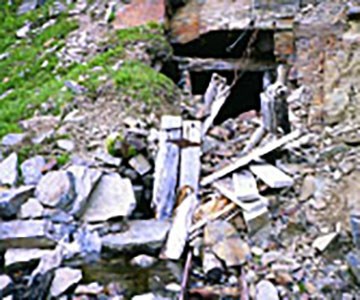Part of a series of articles titled The Legacy of ANILCA.
Article
Abandoned Mineral Land Restoration Activities in Alaska
By Lynn Griffiths

National Park Service photograph by Lynn Griffiths
The AML program has focused on two distinct aspects of land restoration. The first is the safety of park visitors. A seemingly endless number of hazards exist—under-ground mine openings including shafts and adits, deteriorating equipment, hazardous materials, explosives, and deteriorating structures. The Kennecott mine, which was created to extract copper ore, in Wrangell-St. Elias National Park and Preserve is an example of a mine where visitor safety is a concern. It has 70 miles of dangerous underground workings with numerous openings, and deteriorating mill buildings and equipment. Methods used to close unsafe mines include steel gates made of manganal steel (jail cell steel), polyurethane plugs and blasting to collapse openings.
The second emphasis of the program has been restoration of disturbed lands, primarily those in flood plains and riparian habitat disturbed by placer mining. Restoration projects have used innovative methods to remove hazardous waste, reduce hazardous conditions, reshape the mined area to approach original surface contours, meander streams, and promote stream bank stabilization, sediment control, and revegetation by indigenous plants.
Upper Caribou Creek, in the Kantishna area of Denali is an example of a restoration project of a placer mined area. Sections of the stream bed have been mined from bank to bank. Restoration activities included removing hazardous materials and equipment from the park, leveling and contouring large tailings piles establishing more natural channel meanders, and applying erosion controls.
Many mined areas remain to be restored and made safe for public use. The National Park Service will continue this work in an effort to protect the public and preserve mining history in Alaska National Parks.
Last updated: October 23, 2021
